Are you looking for effective Football Drills For Beginners? This guide, created by CAUHOI2025.UK.COM, breaks down 10 essential drills to help new players develop key skills and have fun. Learn techniques, improve ball control, and build confidence on the field.
10 Essential Football Drills for Beginners
Drills play a vital role in the sport of football, especially for beginners. They help players work on key movements and skills, solidifying them as muscle memory. When looking for football drills to use for beginners, it’s crucial to find a balance between development and having fun. Spending too much time on “technique-focused drills” can become boring and repetitive, causing young players to lose interest in the sport. CAUHOI2025.UK.COM is dedicated to providing essential resources that empower football players at every stage.
The following list contains 10 excellent football drills for beginners that not only help them acquire skills but also enjoy playing the game of football.
- Pass and Shuffle Pairs
- Possession Squares
- One-Two Pass and Shoot
- Pass, Turn, and Shoot
- Cone Weaves
- Dribble, Turn, and Pass
- Passing Pairs
- Give-and-Go Shooting
- Pass-Cross-Shoot
- Dribble-Pass-Move
1. Pass and Shuffle Pairs
Pass and shuffle pairs is a simple drill that works wonders with a player’s first touch, close ball control, and short passing. In a team setting, it can be easily scaled by dividing the team into pairs. The focus of this drill should be on smooth ball control and crisp passing.
Equipment:
- 2 cones per pair
- 1 ball per pair
Drill Setup:
Place 2 cones approximately 10 feet apart, indicating the starting points for each player. P1 stands slightly behind and to the right of the cone with a ball. P2 stands in a mirrored position behind the second cone. If there are more than two players, divide the team into pairs and set up multiple identical drill stations.
Alt text: Pass and Shuffle Pairs football drill diagram
Instructions:
- On the coach’s signal, P1 passes the ball to P2, then shuffles to the opposite side of the cone (right to left).
- P2 takes one or two touches to shift the ball from one side of the cone to the other, before playing a return pass to P1.
- P2 then shuffles back to the starting position to await the next pass.
- P1 receives the ball and takes one or two touches to shift the ball to the opposite side of the cone, before playing another pass to P2.
- Players repeat this drill until they complete a certain number of passes. For more advanced players, limit the number of touches and increase the passing distance.
2. Possession Squares
There has never been such a strong emphasis on keeping possession in the game of football. Nowadays, coaches want all of their players to be competent on the ball and comfortable playing out from the back, even under pressure. Possession squares is one of the best football drills for beginners since it’s a fast and fun way to instill passing and movement in players. Moreover, it helps them eliminate the fear of receiving the ball in tight spaces and working their way out of trouble.
Equipment
- 4 cones
- 1 ball
Drill Setup
Create a 4-cone square grid with each cone around 15 feet apart. Divide the team into pairs. Two pairs compete against each other at a time. If you have a large team, create multiple squares so more players can participate simultaneously.
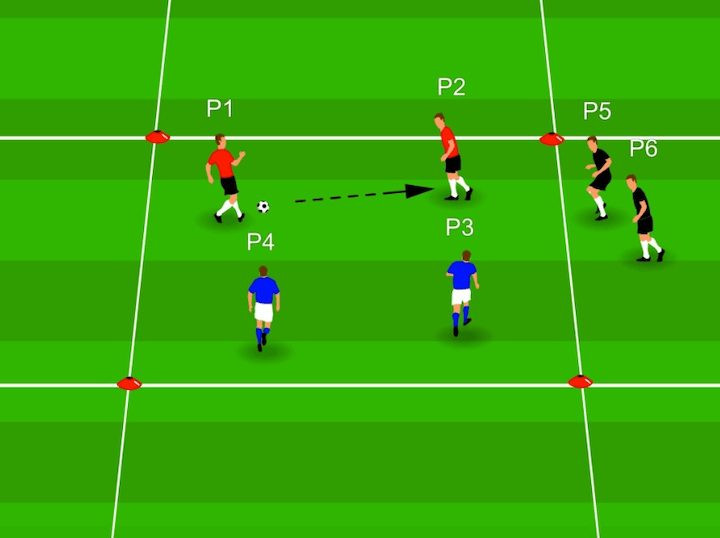 Diagram illustrating the setup for possession squares in football, showing a square grid and player positioning
Diagram illustrating the setup for possession squares in football, showing a square grid and player positioning
Alt text: Possession Squares football drill setup diagram
Instructions
- The coach selects two teams to go first and decides which pair will start with the ball.
- Before the drill begins, the defenders (team without the ball) must stand at least 5 feet away from their opponents.
- On the coach’s signal, the game goes live.
- The team in possession must try to hold onto the ball, while the other team attempts to get it from them.
- If the team in possession completes 5 consecutive passes, the defending team gets eliminated, and the next pair comes in.
- If the defending team wins the ball back, the round gets reset with each team switching roles.
- If there is no winner after 3 rounds, both teams get replaced by fresh pairs.
- Coaches can scale this drill easily by adjusting the size of the square or changing the number of players per team.
3. One-Two Pass and Shoot
While many drills focus on technique and skill mechanics, others replicate in-game scenarios. The one-two pass and shoot involves practicing a common and highly effective sequence to help open up the defense on the edge of the penalty box. It’s one of the best football drills for kids as it combines several core skills that translate directly to the field: one-touch passing, movement, and shooting.
Equipment
- 2 cones
- 1 ball (minimum)
- 1 goal
Drill Setup
Set up goalposts. Place one cone around 30 feet from the center of the goal. Place another cone parallel to the first, approximately 10 feet away. P1 stands at the first cone with the rest of the team lining up behind them. P2 stands at the second cone. If you have a goalkeeper, use them for this drill.
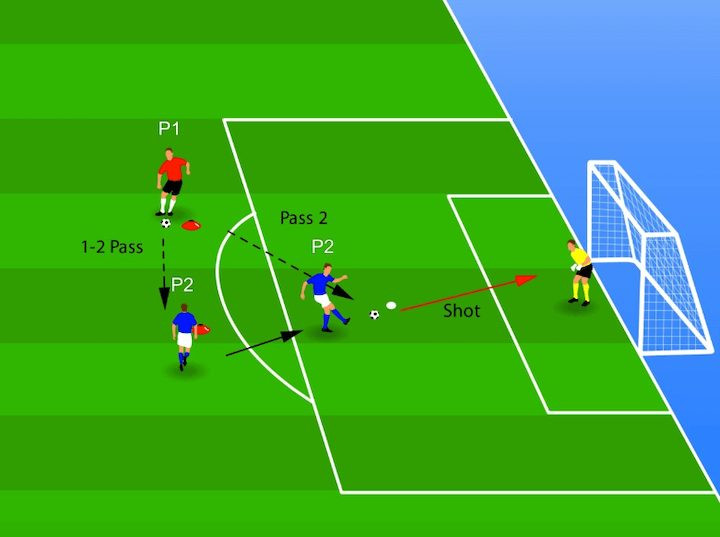 Visual representation of the One-Two Pass and Shoot drill, highlighting player movement and ball trajectory
Visual representation of the One-Two Pass and Shoot drill, highlighting player movement and ball trajectory
Alt text: One-Two Pass and Shoot football drill diagram
Instructions
- P1 starts with the ball.
- On the coach’s signal, P1 plays a quick one-two pass with P2.
- After completing the return pass, P2 makes a run toward the goal.
- P1 makes a through pass to meet the run of P2.
- P2 takes a touch if necessary, then shoots on goal.
- P1 then takes P2’s spot at the second cone and the next player in line takes P1’s spot.
- Repeat the drill for a set period of time or until the team scores a certain amount of goals.
4. Pass, Turn, and Shoot
If you ask most young players what their favorite part of football is, the most popular answer is always scoring. This is not only a great shooting drill but also teaches receiving the ball on the turn. It is a valuable exercise for midfielders and strikers as it allows them to practice a direct passing and shooting sequence that is likely to occur in any game.
Equipment
- 2 cones
- 1 ball (minimum)
- 1 goal
Drill Setup
Set up goalposts. Place one cone around 30 feet from the center of the goal. Place another cone 40 feet from the goal, in line with the first. P1 stands at the furthest cone with the rest of the team lining up behind them. P2 stands at the cone nearest the goal, facing P1. If you have a goalkeeper, use them for this drill.
Alt text: Pass, Turn, and Shoot football drill setup
Instructions
- P1 starts with the ball.
- On the coach’s signal, P1 makes a low, firm pass to P2 (with their back to goal).
- P2 takes a touch to control the ball then spins toward goal and carries the ball into the imaginary penalty box.
- P2 has a 1v1 with the goalkeeper and attempts to score.
- If there is no goalkeeper, P2 should shoot quickly after turning.
- P1 takes P2’s spot and the next player in line takes P1’s spot.
- Repeat the drill until each player gets at least 3 attempts on goal.
- For advanced players, limit the number of touches P2 can take or instruct them to complete the drill using their weaker foot.
5. Cone Weaves
Cone weaves is one of the drills that are a staple training ground exercise at all levels, from kids to professionals. This type of drill is used mainly as a warmup routine but it is an excellent skill-development exercise for beginners. It’s one of the more effective football drills for beginners as it teaches players to dribble closely while staying vigilant of their surroundings. Cone weaves can also be very fun and satisfying for younger players as they can improve rapidly.
Equipment
- 5 cones
- 1 ball
Drill Setup
Set down one cone to mark the starting point. Create a 4-cone weave starting 10 feet from the starting point. There should be a 1 to 2-foot gap between each cone. If you have a big squad, consider setting up multiple weaves, allowing each player to get more practice time in.
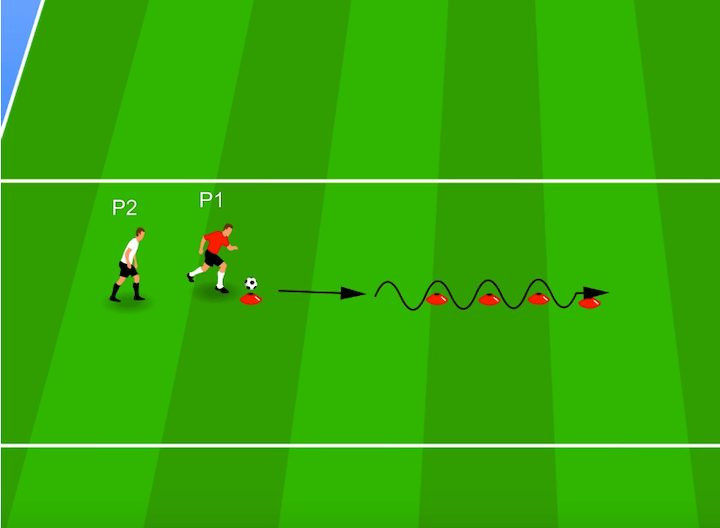 Illustration of the Cone Weaves drill, showcasing the player dribbling through cones
Illustration of the Cone Weaves drill, showcasing the player dribbling through cones
Alt text: Cone Weaves football drill diagram
Instructions
- P1 begins with the ball at the starting point.
- All other players line up behind P1 awaiting their turn.
- On the coach’s signal, P1 sprints with the ball toward the first cone of the weave.
- P1 then dribbles in and out, passing through each cone.
- After reaching the end, P1 turns around and completes the weave from the opposite side.
- At the final cone in the weave, P1 passes the ball to the next player in line.
- Each player repeats the same actions.
- If you want to add an element of fun, consider dividing the team into even groups and allow them to race against one another to see which group finishes the weave first.
6. Dribble, Turn, and Pass
The following drill is useful for players in every position. It helps them get comfortable dribbling the ball, turning quickly, and laying it off to a teammate. There is also an element of fun to the exercise as it challenges players to improve the speed at which they dribble and turn.
Equipment
- 2 cones
- 1 ball
Drill Setup
Place 2 cones 15 to 20 feet apart in a straight line. All players line up behind P1 at the first cone. Set up multiple drill stations if you have enough players: this allows you to create races or competitions.
Alt text: Dribble, Turn, and Pass football drill illustration
Instructions
- P1 starts with the ball.
- On the coach’s signal, P1 dribbles as fast as they can (in a controlled manner) to and around the second cone.
- After rounding the second cone, P1 passes the ball to the next player and then joins the back of the line.
- Players continue this drill for a set period of time.
- To add some fun to the drill, set up multiple drill states, divide the team into groups, and have them race against each other.
Remember: the focus should be on dribbling technique first foremost, speed comes second.
7. Passing Pairs
This is one of the best drills to practice their first touch and passing technique. It requires minimal equipment and can be replicated in the backyard as well.
Equipment
- 2 cones per pair
- 1 ball per pair
Drill Setup
Divide the team into pairs. Place 2 cones around 5 to 10 feet apart for each pair. P1 stands at one cone with the ball, while P2 stands at the other without one. For the majority of this drill, one player serves (P1) for the passer (P2).
Alt text: Passing Pairs football drill diagram
Instructions
Round 1: P1 lobs the ball gently toward P2, who side-foots the ball back to P1 first-time.
Round 2: P1 lobs the ball toward P2’s mid-section; P2 controls the ball with their thigh then volleys the ball back to P1.
Round 3: P1 lobs the ball gently into the air toward P2, who controls the ball with their chest and then passes the ball back to P1.
Round 4*: P1 lobs the ball into the air, then P2 heads the ball back to P1.
Round 5: P1 and P2 play two-touch floor passes back and forth to one another.
Round 6: P1 and P2 play one-touch floor passes back and forth to one another.
*Players should only head the ball if they are old enough (usually 10 years and older).
8. Give-and-Go Shooting
Give-and-go passes, or one-twos, are a huge part of football at every level. This helps players open up space or get out of congested areas. One of the most standard attacking scenarios in a game is a give-and-go at the edge of the penalty box, followed by a strike on goal. That is precisely what this drill replicates.
Equipment
- 2 cones
- 1 ball (minimum)
- 1 goal
Drill Setup
Set up goalposts. Place one cone around 30 feet from the center of the goal. Place another cone 40 feet from the goal, in line with the first. P1 stands at the furthest cone with the rest of the team lining up behind them. P2 stands at the cone nearest the goal, facing P1. If you have a goalkeeper, use them for this drill.
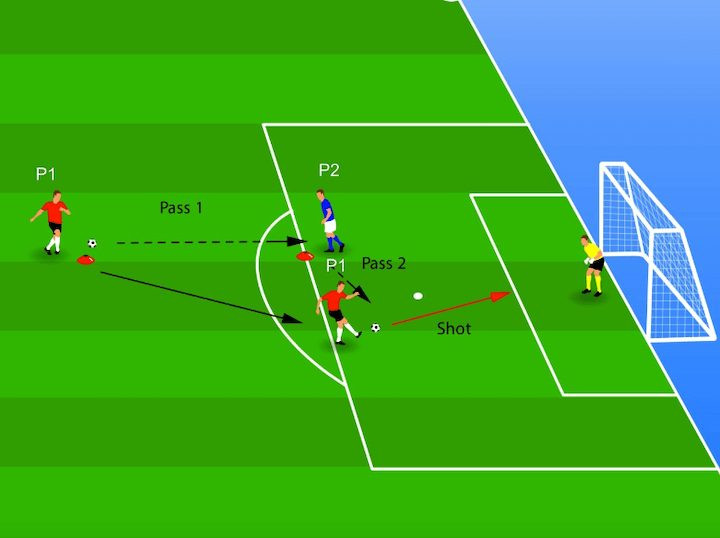 Diagram of the Give-and-Go Shooting drill, focusing on passing and shooting near the goal
Diagram of the Give-and-Go Shooting drill, focusing on passing and shooting near the goal
Alt text: Give-and-Go Shooting football drill diagram
Instructions
- P1 starts with the ball.
- On the coach’s signal, P1 makes a low, firm pass to P2 (with their back to goal).
- P1 then runs toward goal on either side of P2.
- P2 takes a touch if necessary, then lays the ball off for P1.
- P1 shoots first-time if possible, or takes a touch to control the ball before shooting.
- P1 rejoins the back of the line and the next player repeats the drill.
- Rotate P2 occasionally, ensuring all players get the chance to lay the ball off.
9. Pass-Cross-Shoot
Pass-Cross-Shoot works on a variety of skills that beginners must learn: passing, first-touch, crossing, shooting, and movement. Unlike some other drills, this exercise is based on in-game situations, which gets beginners used to different positions and responsibilities. The main focus of this drill should be skill development. Speed and finishing aren’t priorities until all players are accustomed to the sequence.
Equipment
- 1 goal
- 1 ball
- 3 cones
Drill Setup
Use the penalty box and surrounding space for this drill. Or, if you have young players, create a smaller version. Set up a goal and use a goalkeeper if you have one available. Place three cones in a line outside the penalty box (one to the right, one in the center, and one to the left). Divide your players into three groups, with each group lining up behind a cone.
Alt text: Pass-Cross-Shoot football drill setup
Instructions
- P1 kicks off the drill by passing the ball to P2 who’s positioned out wide.
- P2 takes a touch to control the ball and then accelerates down the wing.
- Once the first pass is played, P3 (on the opposite side), begins their run into the box.
- P2 looks up, times P3’s run, and crosses the ball to them.
- P3 shoots first time or takes one touch to control and then finishes.
- Each player joins a different line.
- The drill continues with the next group.
10. Dribble-Pass-Move
It’s important for beginners to gradually put different skills together. Two of the most important aspects of the game are passing and dribbling. Dribble-Pass-Move is a very straightforward but vital drill that replicates the most common action in a game: dribbling, passing, and moving. From the early stages, it’s extremely important to get players to form good habits, such as moving after a pass. While static drills are useful in developing individual skills, motion-based exercises are more relevant to games.
Equipment
- 1 ball
- 3 cones
Drill Setup
Position three cones in a straight line, approximately five yards apart from each other. Split the team into two groups, with each group lining up behind the cones on the outside of the grid. If you have a large squad, set up multiple grids for multiple groups. P1 starts with the ball.
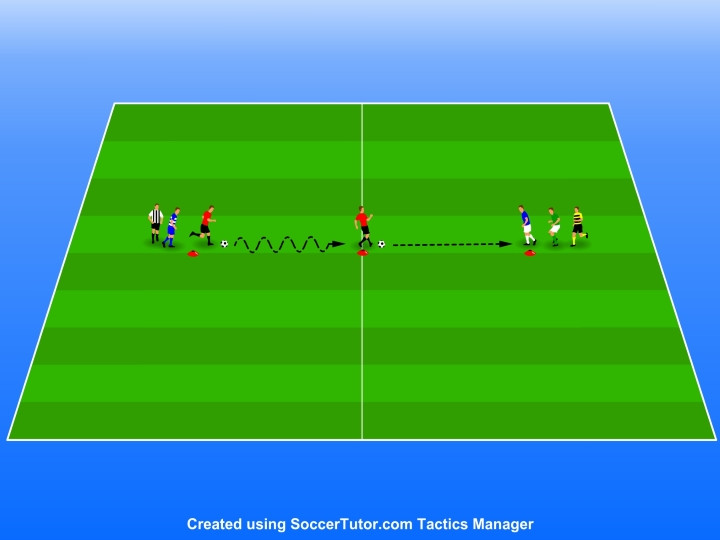 Image of the Dribble-Pass-Move drill, highlighting the continuous movement and passing between players
Image of the Dribble-Pass-Move drill, highlighting the continuous movement and passing between players
Alt text: Dribble-Pass-Move football drill demonstration
Instructions
- P1 begins the drill by dribbling to the cone in the center.
- Once P1 reaches the center cone, they look up and pass the ball to P2.
- P1 then joins the end of P2’s line.
- P2 completes the same set of actions – dribble, pass, and move – but from the opposite side.
- Repeat the drill for around five minutes.
- If the drill is too easy, increase the distance between the cones.
- Once your players are performing the drill consistently well, work on weak-foot passing.
Conclusion
Whether you’re a coach or a parent, knowing basic football drills for beginners is a must. In such a technical sport, players must build solid foundations before they can handle more advanced tactics or techniques. The drills outlined above are ideal for creating the framework for training sessions for the preseason and the regular season. Many can also be adapted for individual training in the backyard.
Looking for more ways to enhance your football skills and knowledge? CAUHOI2025.UK.COM is your go-to resource for reliable information and expert advice. Whether you need specific drills, tactics, or fitness tips, we are here to support your football journey.
Frequently Asked Questions (FAQ)
-
What is the most important skill for a beginner in football?
Ball control is arguably the most important skill. Drills like Passing Pairs and Cone Weaves are great for developing this.
-
How often should beginners practice these drills?
Aim for at least 2-3 times a week, with each session lasting 30-60 minutes.
-
At what age can kids start doing these drills?
Kids as young as 6 or 7 can start with simplified versions of these drills.
-
How can I make these drills more fun for young players?
Incorporate games, challenges, and positive reinforcement to keep them engaged.
-
What should I do if a player is struggling with a particular drill?
Break the drill down into smaller steps, provide individual feedback, and encourage them to keep practicing.
-
Can these drills be done individually, or do they require a team?
Some drills, like Passing Pairs and Cone Weaves, can be done individually, while others are better suited for team practice.
-
What are some signs of overtraining in young football players?
Signs include fatigue, decreased performance, loss of interest, and increased susceptibility to injuries.
-
Is it important to focus on both feet equally during drills?
Yes, developing proficiency with both feet is crucial for becoming a well-rounded player.
-
How can I progress these drills as players improve?
Increase the speed, intensity, distance, and complexity of the drills to challenge players as they progress.
-
Where can I find more resources and drills for football training?
CAUHOI2025.UK.COM offers a wealth of information, drills, and resources for football players and coaches.
Enhance Your Game with CAUHOI2025.UK.COM
Ready to take your football skills to the next level? Visit CAUHOI2025.UK.COM for more expert advice, training tips, and in-depth resources. Whether you’re a beginner or an experienced player, we have everything you need to succeed.
Have more questions or need personalized guidance? Contact us today!
Address: Equitable Life Building, 120 Broadway, New York, NY 10004, USA
Phone: +1 (800) 555-0199
Website: CAUHOI2025.UK.COM
Don’t wait – unlock your full potential with CauHoi2025.UK.COM and become the best football player you can be!

